Streamflow Consumption vs. Climate Change in the Evolution of Discharge in the Tarim River Basin, Northwest China
Abstract
:1. Introduction
2. Materials and Methodology
2.1. Study Area
2.2. Data Sources
2.3. Trend Analysis
2.4. Quantifying the Impacts of Climate and Human Activity
3. Results and Discussion
3.1. Trends of Hydrological and Climatic Variables
3.1.1. Changes in River Flow
3.1.2. Changes in Precipitation and Temperature
3.1.3. Changes in Evaporation
3.2. Land-Use Changes in the Mainstream Tarim River Basin
3.3. Effects of Climate and Land-Use Changes on Streamflow Consumption Processes
4. Conclusions
Author Contributions
Funding
Institutional Review Board Statement
Informed Consent Statement
Data Availability Statement
Acknowledgments
Conflicts of Interest
References
- Ye, X.C.; Zhang, Q.; Liu, J.; Li, X.H.; Xu, C.Y. Distinguishing the relative impacts of climate change and human activities on variation of streamflow in the Poyang Lake catchment, China. J. Hydrol. 2013, 494, 83–95. [Google Scholar] [CrossRef]
- Gao, G.; Fu, B.; Wang, S.; Liang, W.; Jiang, X. Determining the hydrological responses to climate variability and land use/cover change in the loess plateau with the budyko framework. Sci. Total Environ. 2016, 557–558, 331–342. [Google Scholar] [CrossRef] [PubMed]
- Neupane, R.P.; Kumar, S. Estimating the effects of potential climate and land use changes on hydrologic processes of a large agriculture dominated watershed. J. Hydrol. 2015, 529, 418–429. [Google Scholar] [CrossRef]
- Nosetto, M.D.; Jobbágy, E.G.; Brizuela, A.B.; Jackson, R.B. The hydrologic consequences of land cover change in central Argentina. Agr. Ecosyst. Environ. 2012, 154, 2–11. [Google Scholar] [CrossRef]
- Tian, H.; Lu, C.; Chen, G.; Xu, X.; Liu, M.; Ren, W.; Tao, B.; Sun, G.; Pan, S.; Liu, J. Climate and land use controls over terrestrial water use efficiency in monsoon Asia. Ecohydrology 2011, 4, 322–340. [Google Scholar] [CrossRef]
- Morán-Tejeda, E.; Zabalza, J.; Rahman, K.; Gago-Silva, A.; López-Moreno, J.I.; Vicente-Serrano, S.; Lehmann, A.; Tague, C.L.; Beniston, M. Hydrological impacts of climate and land-use changes in a mountain watershed: Uncertainty estimation based on model comparison. Ecohydrology 2015, 8, 1396–1416. [Google Scholar] [CrossRef]
- Pankaj, D.; Ashok, M. Separating the impacts of climate change and human activities on streamflow: A review of methodologies and critical assumptions. J. Hydrol. 2017, 548, 278–290. [Google Scholar]
- Wheater, H.S.; Mathias, S.A.; Li, X. Groundwater Modelling in Arid and Semi-Arid Areas; Cambridge University Press: New York, NY, USA, 2010; pp. 11–19. [Google Scholar]
- Costa, A.C.; Foerster, S.; de Araújo, J.C.; Bronstert, A. Analysis of channel transmission losses in a dryland river reach in north-eastern Brazil using streamflow series, groundwater level series and multi-temporal satellite data. Hydrol. Processes 2013, 27, 1046–1060. [Google Scholar] [CrossRef] [Green Version]
- Hu, Y.; Duan, W.; Zou, S.; Pmka, B. An integrated assessment of runoff dynamics in the amu darya river basin: Confronting climate change and multiple human activities, 1960–2017. J. Hydrol. 2021, 603, 126905. [Google Scholar] [CrossRef]
- Gokool, S.; Riddell, E.S.; Nel, J.M.; Raubenheimer, R.; Strydom, T.; Swemmer, A.; Chetty, K.T. Quantifying the contribution of riparian total evaporation to streamflow transmission losses: Preliminary investigations along the Groot Letaba river. Phys. Chem. Earth Parts A/B/C 2019, 114, 102805. [Google Scholar] [CrossRef]
- Yan, Y.; Yang, Z.; Liu, Q. Nonlinear trend in streamflow and its response to climate change under complex ecohydrological patterns in the Yellow River Basin, China. Ecol. Model. 2013, 252, 220–227. [Google Scholar] [CrossRef]
- Yang, S.L.; Shi, B.; Fan, J.; Luo, X.; Tian, Q.; Yang, H.; Chen, S.; Zhang, Y.; Zhang, S.; Shi, X.; et al. Streamflow decline in the yellow river along with socioeconomic development: Past and future. Water 2020, 12, 823. [Google Scholar] [CrossRef] [Green Version]
- Dong, W.; Cui, B.; Liu, Z.; Zhang, K. Relative effects of human activities and climate change on the river runoff in an arid basin in northwest China. Hydrol. Processes 2014, 28, 4854–4864. [Google Scholar] [CrossRef]
- Lin, B.; Chen, X.; Yao, H.; Chen, Y.; Liu, M.; Gao, L. Analyses of landuse change impacts on catchment runoff using different time indicators based on swat model. Ecol. Indic. 2015, 58, 55–63. [Google Scholar] [CrossRef]
- Zhang, H.; Xue, L.; Yang, C.; Chen, X.; Zhang, L.; Wei, G. Dynamic assessment on the landscape patterns and spatio-temporal change in the mainstream of Tarim river. In Proceedings of the IOP Conference Series Earth and Environmental Science, Banda Aceh, Indonesia, 26–27 September 2018; Volume 108, p. 032058. [Google Scholar] [CrossRef] [Green Version]
- Zhao, F.; Zhang, L.; Xu, Z.; Scott, D.F. Evaluation of methods for estimating the effects of vegetation change and climate variability on streamflow. Water Resour. Res. 2010, 46, W03505. [Google Scholar] [CrossRef]
- Li, X.; Zhang, Y.; Guo, F.; Gao, X.; Wang, Y. Predicting the effect of land use and climate change on stream macroinvertebrates based on the linkage between structural equation modeling and bayesian network. Ecol. Indic. 2018, 85, 820–831. [Google Scholar] [CrossRef]
- Bai, Y.; Ochuodho, T.O.; Yang, J. Impact of land use and climate change on water-related ecosystem services in Kentucky, USA. Ecol. Indic. 2019, 102, 51–64. [Google Scholar] [CrossRef]
- Zuo, D.P.; Xu, Z.X.; Wu, W.; Zhao, J.; Zhao, F.F. Identification of streamflow response to climate change and human activities in the Wei River Basin, China. Water Resour. Manag. 2014, 28, 833–855. [Google Scholar] [CrossRef]
- Guo, Y.; Li, Z.; Amo-Boateng, M.; Deng, P.; Huang, P. Quantitative assessment of the impact of climate variability and human activities on runoff changes for the upper reaches of Weihe River Stochastic Environ. Res. Risk Assess. 2014, 8, 333–346. [Google Scholar] [CrossRef]
- Yang, H.; Yang, D. Derivation of climate elasticity of runoff to assess the effects of climate change on annual runoff. Water Resour. Res. 2011, 47, W07526.12. [Google Scholar] [CrossRef]
- Ning, T.; Li, Z.; Liu, W. Separating the impacts of climate change and land surface alteration on runoff reduction in the jing river catchment of China. Catena 2016, 147, 80–86. [Google Scholar] [CrossRef]
- Zhao, J.; Huang, S.; Huang, Q.; Wang, H.; Leng, G. Detecting the dominant cause of streamflow decline in the loess plateau of China based onthe latest budyko equation. Water 2018, 10, 1277. [Google Scholar] [CrossRef] [Green Version]
- Tomer, M.D.; Schilling, K.E. A simple approach to distinguish land-use and climate-change effects on watershed hydrology. J. Hydrol. 2009, 376, 24–33. [Google Scholar] [CrossRef]
- Rigby, R.A.; Stasinopoulos, D.M. Generalized additive models for location, scale and shape. J. Appl. Stat. 2005, 54, 507–554. [Google Scholar] [CrossRef] [Green Version]
- Zhao, R.F.; Chen, Y.N.; Shi, P.J.; Zhang, L.H.; Pan, J.H.; Zhao, H.L. Land use and land cover change and driving mechanism in the arid inland river basin: A case study of Tarim River, Xinjiang, China. Environ. Earth Sci. 2013, 68, 591–604. [Google Scholar] [CrossRef]
- Tao, H.; Gemmer, M.; Bai, Y.; Su, B.; Mao, W. Trends of streamflow in the tarim river basin during the past 50years: Human impact or climate change? J. Hydrol. 2011, 400, 1–9. [Google Scholar] [CrossRef]
- Ling, H.; Guo, B.; Zhang, G.; Xu, H.; Deng, X. Evaluation of the ecological protective effect of the “large basin” comprehensive management system in the Tarim river basin, china. Sci. Total Environ. 2019, 650, 1696–1706. [Google Scholar] [CrossRef]
- Yang, F.; Xue, L.; Wei, G.; Chi, Y.; Yang, G. Study on the dominant causes of streamflow alteration and effects of the current water diversion in the Tarim river basin, China. Hydrol. Processes 2018, 32, 3391–3401. [Google Scholar] [CrossRef]
- Chen, Y.N.; Li, W.H.; Xu, C.C.; Hao, X.M. Effects of climate change on water resources in Tarim River Basin, Northwest China. J. Environ. Sci. 2007, 19, 488–493. [Google Scholar] [CrossRef]
- Chen, Y.N.; Xu, C.; Hao, X.M.; Li, W.H.; Chen, Y.P.; Zhu, C.G.; Ye, Z. Fifty-year climate change and its effect on annual runoff in the Tarim River Basin, China. Quat. Int. 2009, 208, 53–61. [Google Scholar]
- Guo, H.; Jiapaer, G.; Bao, A.; Li, X.; Huang, Y.; Ndayisaba, F.; Meng, F. Effects of the Tarim river’s middle stream water transport dike on the fractional cover of desert riparian vegetation. Ecol. Eng. 2017, 99, 333–342. [Google Scholar] [CrossRef]
- Wang, G.X.; Liu, J.Q.; Kubota, J.; Chen, L. Effects of land-use changes on hydrological processes in the middle basin of the Heihe River, northwest China. Hydrol. Processes 2007, 21, 1370–1382. [Google Scholar] [CrossRef]
- Kendall, M.G. Rank Correlation Methods; Charles Griffin: London, UK, 1975; p. 202. [Google Scholar]
- Hastie, T.J.; Tibshirani, R.J. Generalized Additive Models; Chapman & Hall/CRC: London, UK, 1990. [Google Scholar]
- Wood, S.N. Generalized Additive Models: An introduction with R; Chapman & Hall/CRC: Boca Raton, FL, USA, 2006. [Google Scholar]
- Boulain, N.; Cappelaere, B.; Séguis, L.; Favreau, G.; Gignoux, J. Water balance and vegetation change in the Sahel: A case study at the watershed scale with an eco-hydrological model. J. Arid. Environ. 2009, 73, 1125–1135. [Google Scholar] [CrossRef]
- Hietel, E.; Waldhardt, R.; Otte, A. Analysing land-cover changes in relation to environmental variables in Hesse, Germany. Landsc. Ecol. 2004, 19, 473–489. [Google Scholar] [CrossRef]
- Peng, D.M.; Shi, F.Z.; Zhao, C.Y.; Ye, B.S. Factors controlling the spatial variability of surface soil particles using GLM and GAM. Stoch. Env. Res. Risk Assess. 2014, 29, 27–34. [Google Scholar] [CrossRef]
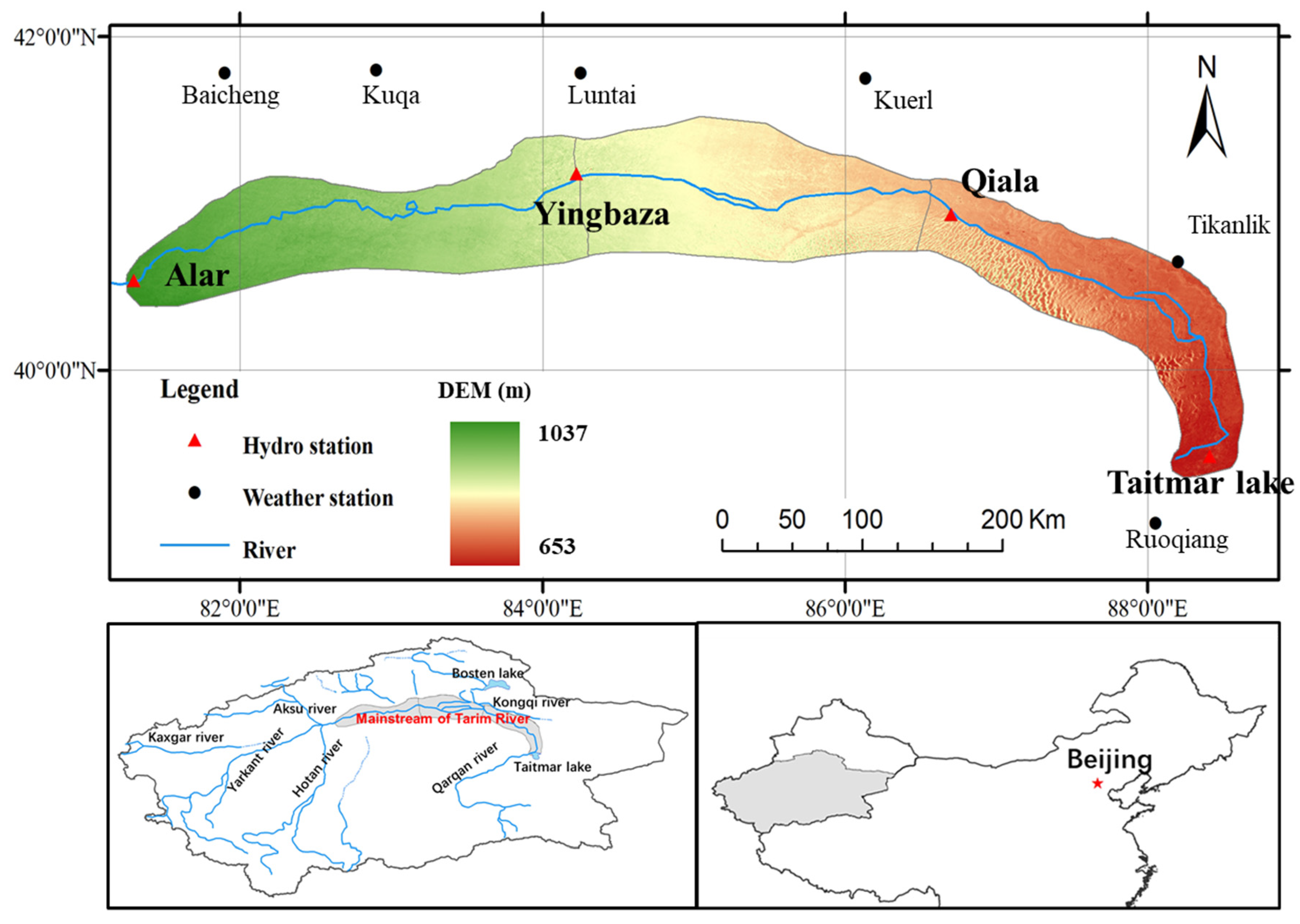
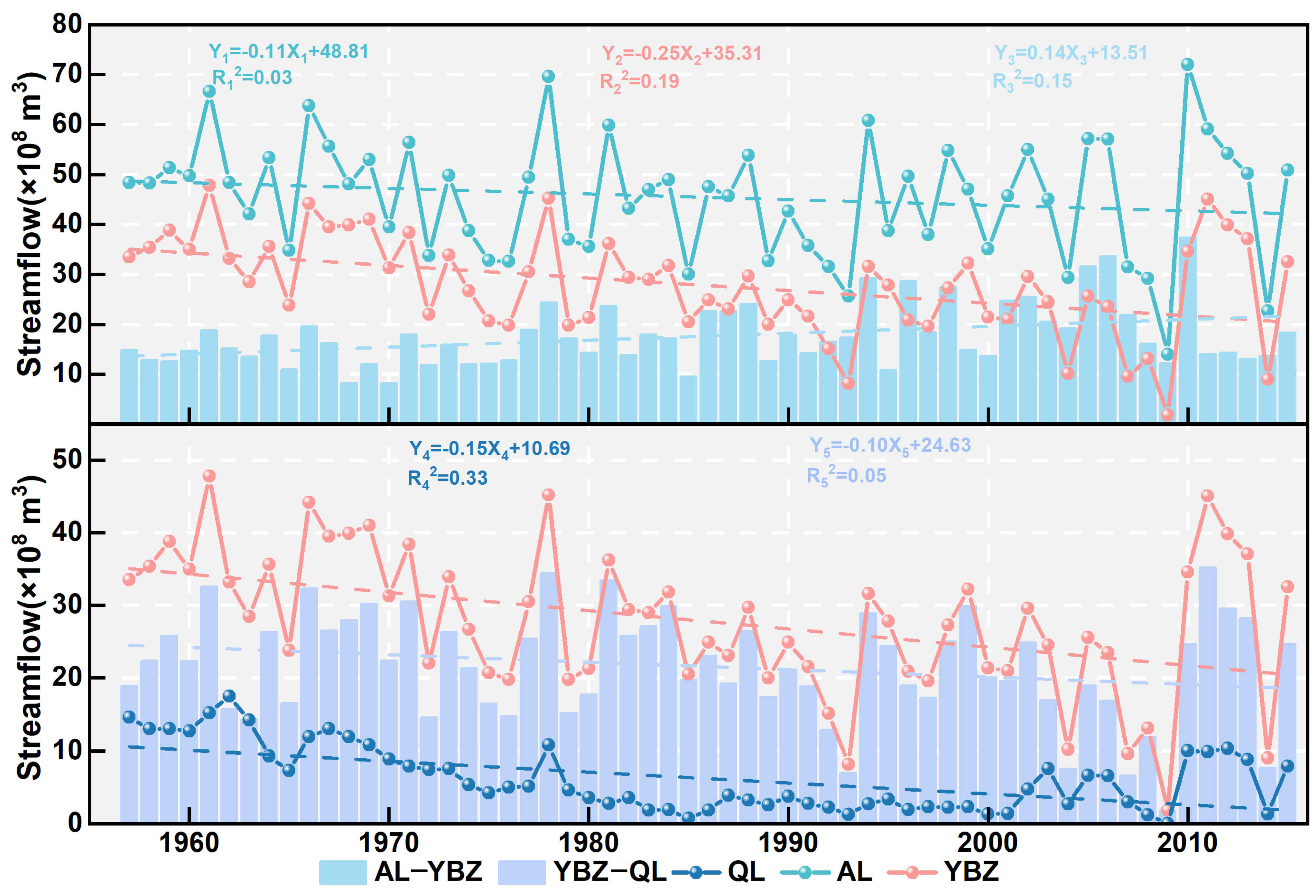
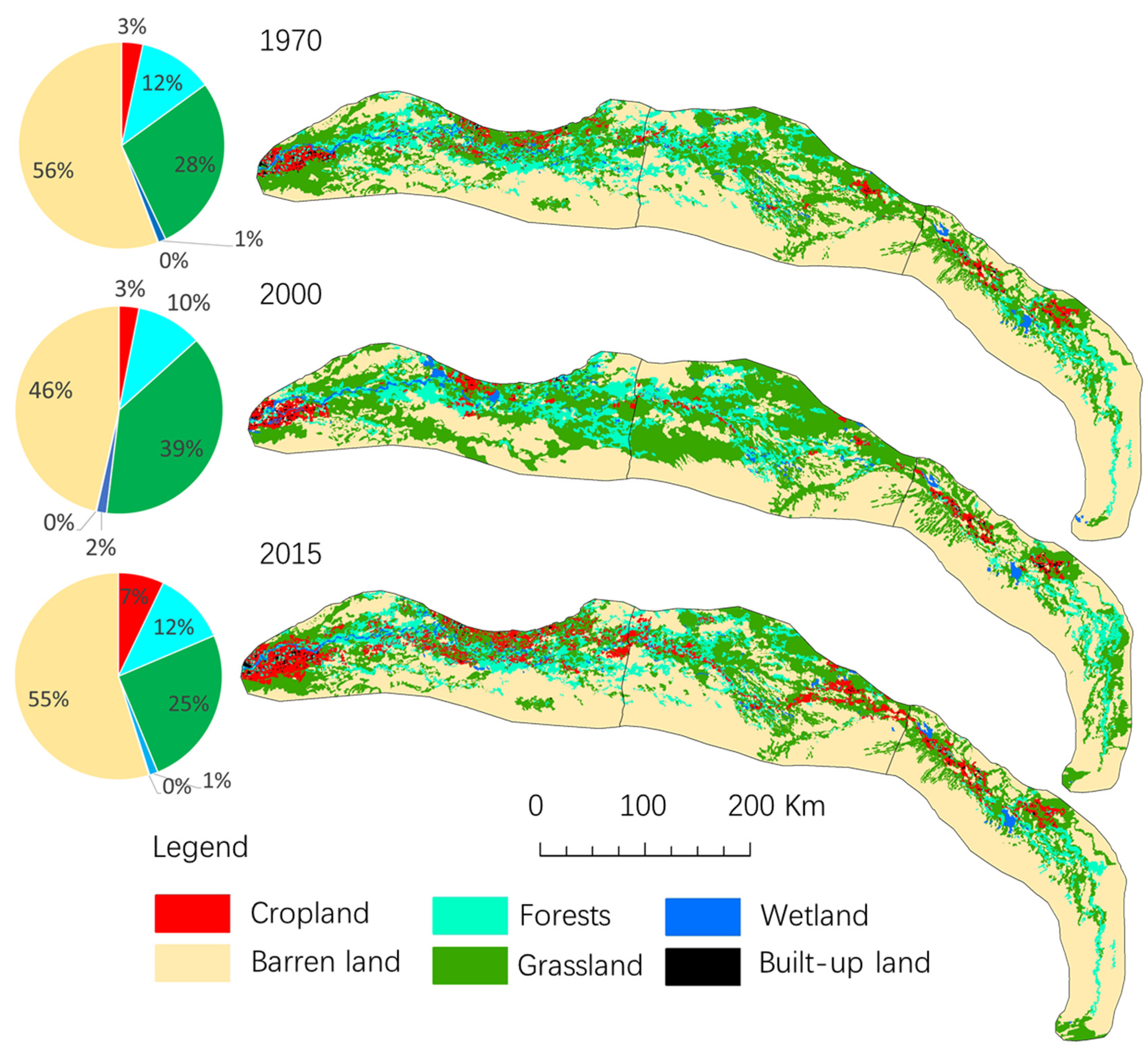
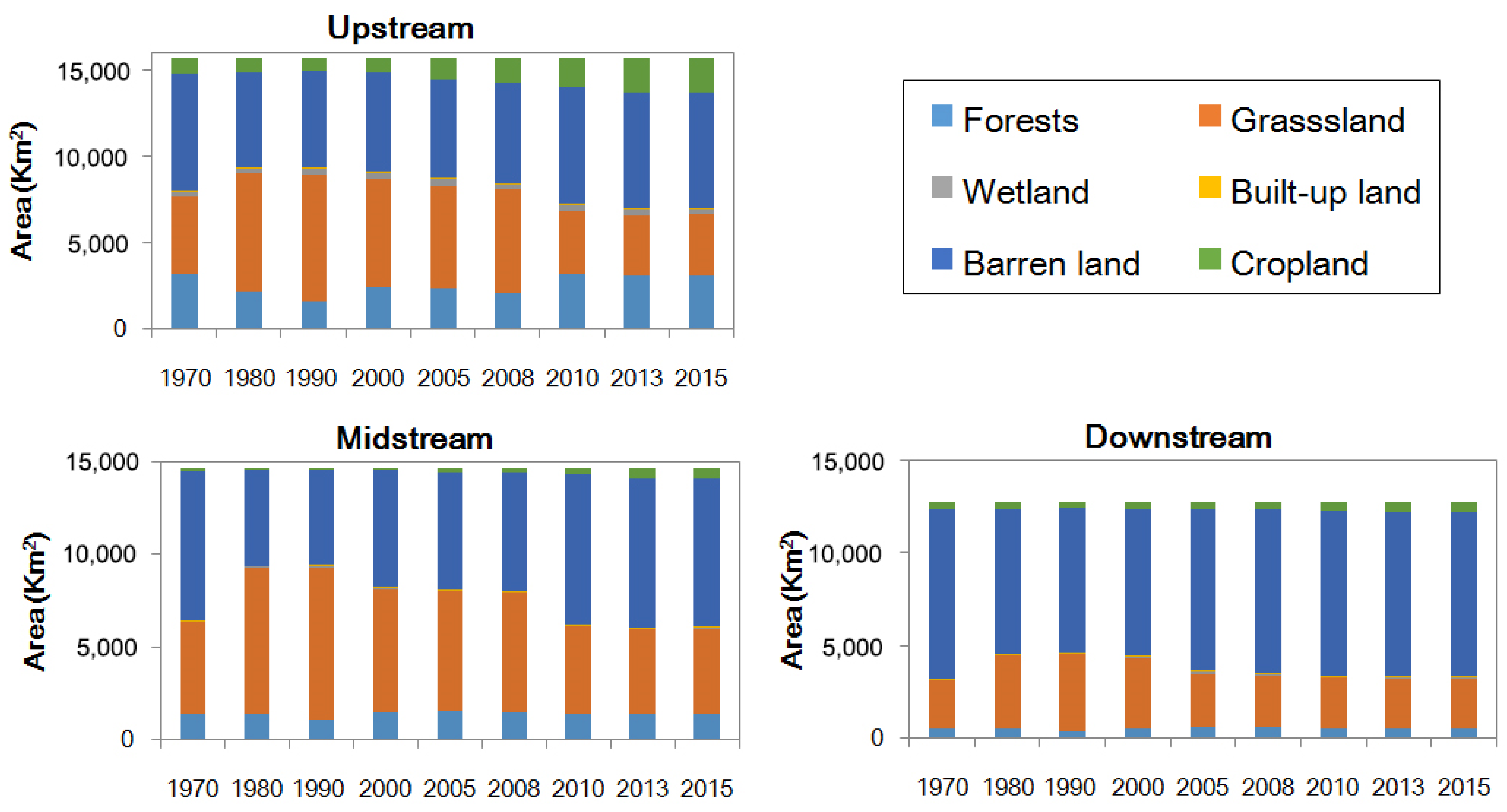
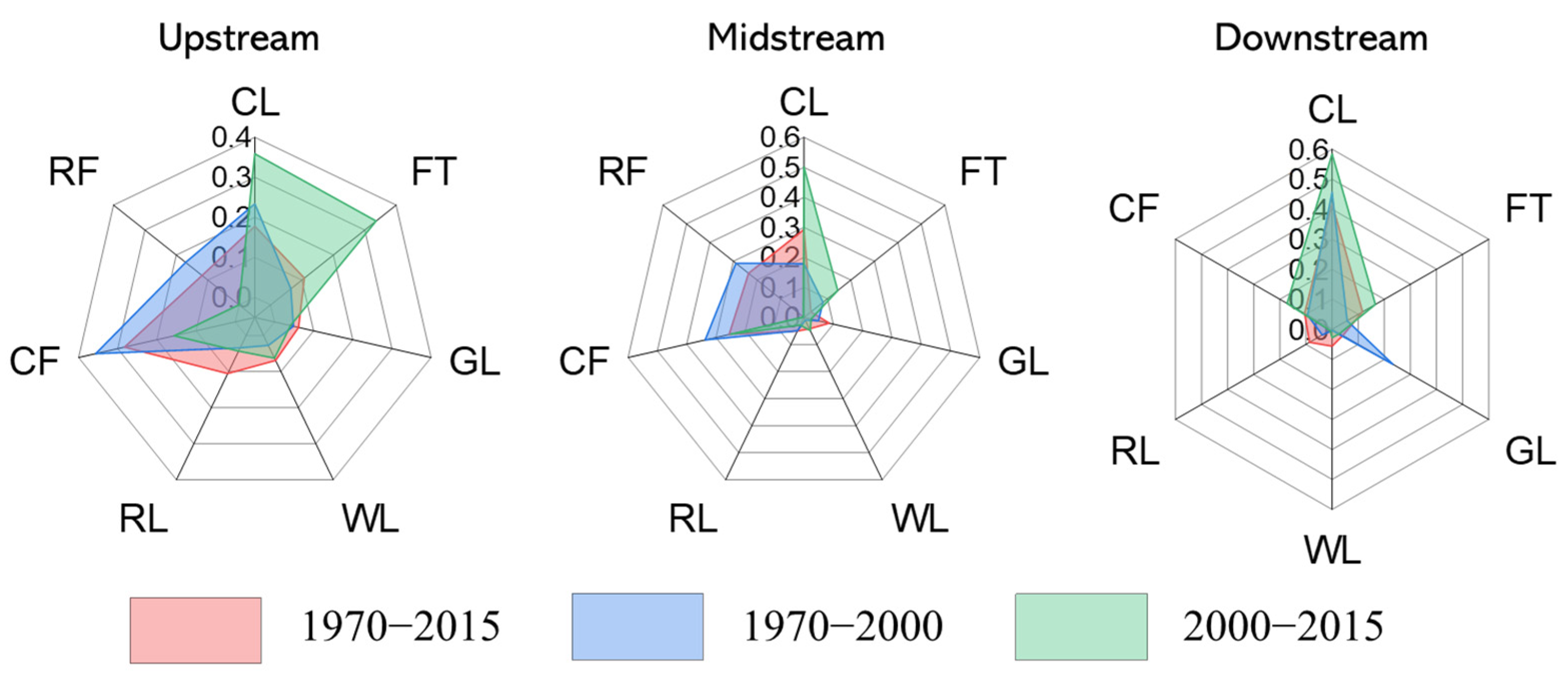
| Time Period | Factors | Upstream | Midstream | Downstream | ||||||
|---|---|---|---|---|---|---|---|---|---|---|
| MK | LM | MK | LM | MK | LM | |||||
| Z | β | Sig. | Z | β | Sig. | Z | β | Sig. | ||
| 1957–2015 | P | 1.85 | 0.61 | 0.00 ** | 0.67 | 0.34 | 0.06 | 1.75 | 0.31 | 0.02 * |
| T | 0.98 | 0.03 | 0.00 ** | 2.23 * | 0.01 | 0.07 | 1.31 | 0.02 | 0.00 ** | |
| E20 cm | −2.45 * | −3.67 | 0.00 ** | −0.79 | −0.67 | 0.65 | −2.14 * | −0.48 | 0.68 | |
| S | −1.11 | −0.11 | 0.11 | −2.13 * | −0.25 | 0.00 ** | −4.34 ** | −0.15 | 0.00 ** | |
| SC | 1.19 | 0.14 | 0.00 ** | −0.12 | −0.10 | 0.01* | −4.26 ** | −0.15 | 0.00 ** | |
| 1970–2000 | P | 0.15 | 0.83 | 0.07 | 1.17 | 0.82 | 0.11 | 0.26 | −0.04 | 0.92 |
| T | 0.71 | 0.02 | 0.04 * | 1.29 | 0.04 * | 0.00 ** | 1.38 | 0.03 | 0.00 ** | |
| E20 cm | 0.40 | 0.02 | 0.99 | 0.23 | −6.92 | 0.03 * | −0.21 | 0.37 | 0.89 | |
| S | −0.38 | −0.06 | 0.79 | −1.02 | −0.27 | 0.07 | −3.11 ** | −0.20 | 0.00 ** | |
| SC | 1.59 | 0.21 | 0.06 | −0.15 | −0.07 | 0.58 | −2.94 ** | −0.20 | 0.00 ** | |
| 2000–2015 | P | 0.21 | −0.51 | 0.72 | 0.19 | −0.14 | 0.90 | 0.40 | 0.74 | 0.53 |
| T | −0.08 | −0.02 | 0.46 | 0.67 | 0.002 ** | 0.93 | 0.47 | −0.02 | 0.53 | |
| E20 cm | 0.98 | −3.03 | 0.57 | 1.66 | 12.04 | 0.10 | 0.50 | −6.05 | 0.43 | |
| S | 0.18 | 0.17 | 0.85 | −0.06 | 0.68 | 0.34 | 1.06 | 0.31 | 0.12 | |
| SC | 0.19 | −0.50 | 0.26 | −0.94 | 0.36 | 0.50 | 0.78 | 0.31 | 0.12 | |
| Model Factors | Residual Degrees of Freedom | Residual Deviance | Proportion of Total Deviance Explained | AIC Value | Pr(F) | ||||||||||
|---|---|---|---|---|---|---|---|---|---|---|---|---|---|---|---|
| UP | MID | DOWN | UP | MID | DOWN | UP | MID | DOWN | UP | MID | DOWN | UP | MID | DOWN | |
| Initial status | 45 | 45 | 45 | 80,269.5 | 124,538.1 | 24,265.7 | |||||||||
| Cropland | 41 | 41 | 41 | 65,973.0 | 88,074.3 | 14,099.0 | 17.8% | 29.3% | 41.9% | 470.9 | 484.2 | 399.9 | 0.04 * | 0.00 ** | 0.04 * |
| Forests | 37 | 37 | 37 | 57,316.1 | 84,363.3 | 11,265.5 | 28.6% | 32.3% | 53.6% | 466.4 | 484.2 | 391.6 | 0.05 * | 0.04 * | 0.04 * |
| Grassland | 33 | 33 | 33 | 52,365.6 | 73,586.3 | 10,263.9 | 34.8% | 40.9% | 57.7% | 464.3 | 479.9 | 389.3 | 0.11 | 0.07 | 0.49 |
| Wetland | 29 | 29 | 29 | 46,810.2 | 68,332.5 | 8901.5 | 41.7% | 45.1% | 63.3% | 461.1 | 478.5 | 384.7 | 0.65 | 0.70 | 0.17 |
| Residential Land | 25 | 25 | 25 | 38,336.5 | 62,087.1 | 6803.6 | 52.2% | 50.1% | 72.0% | 453.9 | 476.1 | 374.4 | 0.57 | 0.01 ** | 0.09 |
| Precipitation | 21 | 21 | 21 | 32,667.0 | 50,826.2 | 5795.0 | 59.3% | 59.2% | 76.1% | 448.6 | 468.9 | 369.0 | 0.20 | 0.07 | 0.55 |
| Temperature | 17 | 17 | 17 | 25,134.1 | 36,759.6 | 5649.2 | 68.7% | 70.5% | 76.7% | 438.5 | 456.0 | 369.8 | 0.15 | 0.04 * | 0.50 |
| Evaporation | 13 | 13 | 13 | 15,635.7 | 30,284.8 | 4246.5 | 80.5% | 75.7% | 82.5% | 423.5 | 449.1 | 358.7 | 0.06 | 0.07 | 0.02 * |
| Qin(runoff) | 9 | 9 | 9 | 6132.7 | 942.5 | —— | 92.4% | 99.2% | —— | 392.2 | 291.5 | —— | 0.13 | 0.12 | —— |
Publisher’s Note: MDPI stays neutral with regard to jurisdictional claims in published maps and institutional affiliations. |
© 2022 by the authors. Licensee MDPI, Basel, Switzerland. This article is an open access article distributed under the terms and conditions of the Creative Commons Attribution (CC BY) license (https://creativecommons.org/licenses/by/4.0/).
Share and Cite
Shi, F.; Li, X.; Wang, Y.; Ma, X.; Zhu, J.; Zhao, C. Streamflow Consumption vs. Climate Change in the Evolution of Discharge in the Tarim River Basin, Northwest China. Water 2022, 14, 392. https://doi.org/10.3390/w14030392
Shi F, Li X, Wang Y, Ma X, Zhu J, Zhao C. Streamflow Consumption vs. Climate Change in the Evolution of Discharge in the Tarim River Basin, Northwest China. Water. 2022; 14(3):392. https://doi.org/10.3390/w14030392
Chicago/Turabian StyleShi, Fengzhi, Xinhu Li, Yuehui Wang, Xiaofei Ma, Jianting Zhu, and Chengyi Zhao. 2022. "Streamflow Consumption vs. Climate Change in the Evolution of Discharge in the Tarim River Basin, Northwest China" Water 14, no. 3: 392. https://doi.org/10.3390/w14030392
APA StyleShi, F., Li, X., Wang, Y., Ma, X., Zhu, J., & Zhao, C. (2022). Streamflow Consumption vs. Climate Change in the Evolution of Discharge in the Tarim River Basin, Northwest China. Water, 14(3), 392. https://doi.org/10.3390/w14030392










